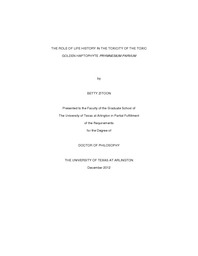
ATTENTION: The works hosted here are being migrated to a new repository that will consolidate resources, improve discoverability, and better show UTA's research impact on the global community. We will update authors as the migration progresses. Please see MavMatrix for more information.
Show simple item record
| dc.contributor.author | Zitoon, Betty | en_US |
| dc.date.accessioned | 2013-03-20T19:11:38Z | |
| dc.date.available | 2013-03-20T19:11:38Z | |
| dc.date.issued | 2013-03-20 | |
| dc.date.submitted | January 2012 | en_US |
| dc.identifier.other | DISS-11998 | en_US |
| dc.identifier.uri | http://hdl.handle.net/10106/11551 | |
| dc.description.abstract | Prymnesium parvum is a harmful algal species that causes widespread fish kills. It is usually motile, but non-motile stages have been observed that may represent an encysted stage. The relationship of these life history changes to the abundance and acute toxicity to fish of P. parvum was studied. As part of research into factors regulating abundance and toxicity of this species, a series of experiments was conducted. The first was a semi-continuous culture experiment examining limiting nutrient (N vs. P), temperature (14 or 20 °C), and dilution rate (at four levels). Samples from the lower temperature generally exhibited greater acute lethal toxicity to fish and toxicity increased with dilution rate. The increase of toxicity with dilution rate was surprising, because increased dilution rate decreases the degree of nutrient limitation and other studies indicate that increased severity of nutrient limitation promotes toxicity. In this study, all cultures contained high proportions of non-motile cells, suggesting a hypothesis that small populations grow larger and deplete nutrients available in the medium, and then release toxins triggered by a stressed environment of decreased nutrient availability. If the environment remains stressful, encystment is eventually triggered, leading to a reduction of toxin production. With the assumption that toxins degrade, we would expect to see toxicity levels decrease. To test a hypothesis that seasonal variations trigger formation of non-motile cells, nutrient-limited laboratory batch cultures contrasted summer and winter conditions typical of Texas inland waters. Another experiment addressed variations of salinity and temperature in a full factorial design with two other factors that might affect life history and acute toxicity to fish: silica availability (cell walls of cysts might be silicified), and mixing by aeration. Another experiment compared nutrient-sufficient and nutrient-limited cultures. An additional treatment added glucose as a carbon source for nutrient-limited cultures, to encourage mixotrophy which is potentially related to toxic activity.Acute toxicity to fish in simulated summer and winter cultures continuously increased for 20 days and then remained very high for another 22 days. This toxic activity did not differ significantly between summer and winter conditions until days 35 and 42, when winter cultures were more toxic. Non-motile cells remained sparse in both treatments, while motile cells dominated. In the four-factor experiment, acute toxicity to fish was significantly related to several interactions among experimental factors, but no strong relationships to non-motile cells were evident. In the remaining experiment, nutrient-sufficient cultures with highest abundance produced the greatest proportion of non-motile cells. In these cultures, acute toxicity to fish varied over time in relation to the numbers of motile cells and dropped when non-motile cells became dominant. In contrast, nutrient-limited cultures maintained lower total abundance, dominance by motile cells, and higher toxicity to fish. These observations suggest that high population density induces the non-motile phase, rather than stressful conditions of nutrient limitation or seasonal variation, which induce higher toxic activity. | en_US |
| dc.description.sponsorship | Grover, James P. | en_US |
| dc.language.iso | en | en_US |
| dc.publisher | Biology | en_US |
| dc.title | The Role Of Life History In The Toxicity Of The Toxic Golden Haptophyte Prymnesium parvum | en_US |
| dc.type | Ph.D. | en_US |
| dc.contributor.committeeChair | Grover, James P. | en_US |
| dc.degree.department | Biology | en_US |
| dc.degree.discipline | Biology | en_US |
| dc.degree.grantor | University of Texas at Arlington | en_US |
| dc.degree.level | doctoral | en_US |
| dc.degree.name | Ph.D. | en_US |
Files in this item
- Name:
- Zitoon_uta_2502D_11998.pdf
- Size:
- 1.490Mb
- Format:
- PDF
This item appears in the following Collection(s)
Show simple item record


